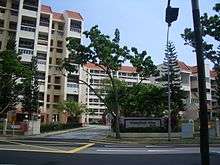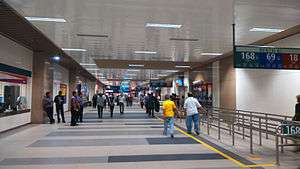Bedok
| Bedok | ||||||||
|---|---|---|---|---|---|---|---|---|
| Planning Area and HDB Town | ||||||||
| Other transcription(s) | ||||||||
| • Chinese | 勿洛 | |||||||
| • Pinyin | Wù luò | |||||||
| • Hokkien | Bût-lo̍k | |||||||
| • Malay | Bedok | |||||||
| • Tamil | பிடோக் | |||||||
| • Tamil romanisation | Piṭōk | |||||||
From top left to right: Panoramic view of Bedok Reservoir, Bedok Stadium, Bedok Reservoir Estate, Bedok Town Centre, Bedok Jetty, Bedok Bus Interchange | ||||||||
 Bedok Location of Bedok in Singapore | ||||||||
| Coordinates: SG 1°19′24.96″N 103°55′38.42″E / 1.3236000°N 103.9273389°E | ||||||||
| Country |
| |||||||
| Region |
| |||||||
| CDCs | ||||||||
| Town councils |
| |||||||
| Constituencies | ||||||||
| DGP exhibited |
| |||||||
| PA incorporated |
| |||||||
| Government | ||||||||
| • Mayors |
North East CDC South East CDC | |||||||
| • Members of Parliament |
Aljunied GRC East Coast GRC Fengshan SMC Marine Parade GRC | |||||||
| Area[2][3] | ||||||||
| • Total | 21.69 km2 (8.37 sq mi) | |||||||
| Area rank | 7th | |||||||
| • Residential | 4.18 km2 (1.61 sq mi) | |||||||
| Population (2015)[2][3][4] | ||||||||
| • Total | 289,750 | |||||||
| • Rank | 1st | |||||||
| • Density | 13,360.5/km2 (34,604/sq mi) | |||||||
| • Density rank | 9th | |||||||
| Demonym(s) |
Official
Colloquial
| |||||||
| Ethnic groups[4] | ||||||||
| • Chinese | 208,880 | |||||||
| • Malays | 43,980 | |||||||
| • Indians | 25,110 | |||||||
| • Others | 11,780 | |||||||
| Postal district | 16 | |||||||
| Dwelling units | 60,115 | |||||||
| Projected ultimate | 79,000 | |||||||
Bedok /bəˈdɒk/ (Chinese: 勿洛, Tamil: பிடோக்) is a planning area and matured residential town located in the East Region of Singapore. Population wise, Bedok is the largest planning area in the Republic, being home to an estimated 289,000 residents.[2][4] This high demographic is largely explained by the affordable public housing in Bedok New Town, due to its relatively distant location from the Central Area. Besides public housing developments, private residences are also prevalent the area, most of which are found in the neighborhoods of Bayshore, Frankel and Siglap, in western and southwestern Bedok.[5][6] Apart from the maritime boundary that the area shares with the Singapore Strait to the south and southeast, Bedok is also bounded by five other planning areas, they are Paya Lebar to the north, Hougang to the northwest, Tampines to the northeast and east, Geylang to the west and Marine Parade to the southwest.
As a part of the Tanah Merah region, the history of Bedok is largely influenced by its coastal frontier. The general area known as Bedok today, was first mentioned in maps dating to the pre-Raffles era. After Singapore was colonized by the British in 1819, Simpang Bedok Village became an ethnically mixed community consisting of Chinese and Malay peoples. Before the 1960s, Bedok's primary source of income was coconut, which was harvested from the plantations that were found in Siglap subzone. Fishing was also another primary source of income for the villagers of Simpang Bedok at the time.[6][7]
Modern development of Bedok only began in 1966, when reclamation works along the coastal area began.[7] In the following decade, Bedok was transformed by the Housing and Development Board (HDB) into the country's fifth self-contained new town, with the first residential flats emerging in the vicinity by 1975.[8] Following the Fall of Saigon that same year, Bedok Jetty became a focal point for Vietnamese refugees landing in Singapore during Operation Thunderstorm.
Etymology
.jpg)
The name, "Bedok" can trace its origins back to 1604, in Manuel Gomes de Erédia's map of Singapore. The map refers to the Bedok River (present day Sungei Bedok) as Sune Bodo.
Bedok is one of the early native place names in existence around the time of Sir Stamford Raffles. In the first comprehensive map of Singapore Island completed by Frankin and Jackson and reproduced in John Crawfurd's 1828 book, the place name appears on the south east coast of the island as a river, Badok S. (Sungei Bedok), around the "small red cliff", a part of present Tanah Merah.
The Malay word bedoh refers to a very large drum, used for calling people to a mosque for prayers or to sound the alarm in the days before loudspeakers. There was a prominent mosque in the 1950s at Jalan Bilal that still used the drum about five times a day. The "h" in the word bedoh was replaced with a "k", and, as with most Malay words that end with a "k", it is pronounced with an inaudible glottal stop.
A less popular theory for its etymology often refers to the Malay term of biduk, a small fishing boat like the sampan, or more likely, a dugout canoe, as the east coast was dotted with many fishing villages.
History
Bedok Town had been developed since 1973 with the newer roads such as Bedok Plain, Bedok Highway and Bedok Heights being built all the way until 1975. The New Upper Changi Road was fully built and opened in 1979, where the massive development had been completed except Bedok Reservoir and Kaki Bukit, which was built later in 1983 - 1988.
Geography
Location
Bedok Planning Area is located within the East Region of Singapore, along Pulau Ujong's southeastern coast. It is bounded by Paya Lebar to the north, Hougang to the northwest, Tampines to the northeast and east, Geylang to the west and Marine Parade to the southwest.
Bedok New Town sits within the Bedok Planning Area.
Subzones
Bedok is divided into 8 subzones:
| Name of estates | Location | Notable structures | Accessibility |
|---|---|---|---|
| Bayshore | Areas along Bayshore Road | East Coast Park, Upper East Coast Bus Terminal, Bedok Jetty, Temasek Secondary School as well as the future Bayshore MRT Station, Bedok South MRT Station and Sungei Bedok MRT Station | Buses |
| Bedok North | Areas along Bedok North Road | Tanah Merah MRT Station, Bedok MRT Station, Bedok Bus Interchange, Bedok Town Centre, Bedok Stadium, Bedok Swimming Complex, Bedok Tennis Centre, Bedok Sports Hall, Bedok Mall, Bedok Point, Bedok Public Library, Bedok Polyclinic, Kampong Chai Chee Community Centre, Fengshan Community Club and Fengshan Primary School | Tanah Merah MRT Station, Bedok MRT Station and buses |
| Bedok Reservoir | Areas surrounding Bedok Reservoir | Bedok Town Park, Bedok Reservoir, Bedok Reservoir Park, Damai Primary School, Damai Secondary School and the future Bedok Reservoir MRT Station | Buses |
| Bedok South | Estates along Bedok South Road | Bedok Community Centre, Bedok View Secondary School, Bedok South Secondary School, Temasek Primary Schol and Temasek Junior College | Buses |
| Frankel | Areas along Telok Kurau Road and Siglap Road | Telok Kurau Park, Opera Estate Primary School, CHIJ (Katong) Primary School, Saint Patrick's School | Kembangan MRT Station and buses |
| Kaki Bukit | Northwest Bedok | Kaki Bukit Industrial Estate, Eunos Community Club, Bedok North Secondary School as well as the future Kaki Bukit MRT Station and Bedok North MRT Station | Buses |
| Kembangan | Areas around Kembangan MRT Station and Chai Chee Estate | Kembangan MRT Station, Kampong Kembangan Community Club, Kampong Kembangan Neighbourhood Police Post, Chai Chee Neighbourhood Police Post, Chai Chee Fire Post, Bedok South Neighbourhood Police Centre, East Coast Primary School and Ping Yi Secondary School | Kembangan MRT Station and buses |
| Siglap | Areas along Marine Vista and Siglap Link | East Coast Park, Victoria School, Victoria Junior College and the future Siglap MRT Station | Buses |
Infrastructure

Bedok New Town covers a land area close to 9.4 km² with some 42% occupied for residential use. It was formerly a hilly region and hence the focal point of orientation of the town is the special landscaped park and sports complex built on the higher ground of the town. The residential blocks as well as the industrial area are planned based on the neighbourhood concept. There is also a town centre together with Bedok Mall and Bedok Point being built. Plans for an integrated complex, which will be as big as 3 football fields, have also been revealed in 2014. This complex will house a sports centre, library, clinic, centre for the elderly and the Kampong Chai Chee Community Club. The complex will be located in Bedok town centre and will be ready in 2017.
Residential development
There are some 58,000 units of flats built by the HDB in Bedok New Town. As one of the older towns, the majority of the flats are 3-room or 4-room. There are also some 2,700 and 583 units of executive and Housing and Urban Development Corporation flats. It provides housing for some 200,000 residents.
Transportation
The Mass Rapid Transit station, Bedok MRT Station, serves the Bedok neighbourhood and is centrally located, at the south-west corner of Bedok Town Center. Adjacent to the MRT station on the north side is the Bedok Bus Interchange, a major bus terminal connecting residents with SBS Transit Townlink and Feeder services 222, 225G, 225W, 228, 229 and Trunk services. SMRT Buses also operates as a minority, Trunk service 854 towards Yishun and shuttle services towards Tampines Retail Park.
Education
Primary Schools
- Bedok Green Primary School
- Damai Primary School
- East Coast Primary School
- Fengshan Primary School
- Haig Girls' School (Temporary)
- Opera Estate Primary School
- Red Swastika School
- Saint Anthony's Canossian Primary School
- St. Stephen's School
- Telok Kurau Primary School
- Temasek Primary School
- Yu Neng Primary School
Secondary Schools
- Anglican High School
- Bedok Green Secondary School
- Bedok North Secondary School
- Bedok South Secondary School
- Bedok View Secondary School
- Damai Secondary School
- Ping Yi Secondary School
- Saint Anthony's Canossian Secondary School
- Victoria School
- Temasek Secondary School
Junior Colleges
Other Schools
- Global Indian International School (GIIS), East Coast Campus
- Katong School (APSN)
- NPS International School
- Sekolah Indonesia Singapura
See also
| Wikimedia Commons has media related to Bedok. |
References
- 1 2 "Singapore Infopedia - Development guide plan". National Library Board.
- 1 2 3 City Population - statistics, maps and charts | Bedok
- 1 2 HDB Key Statistics FY2014/2015
- 1 2 3 "Singapore Residents by Planning Area/Subzone, 2015" (XLS). Singapore Department of Statistics.
- ↑ URA Planning Area Brochure - Bedok
- 1 2 Singapore Infopedia | Bedok
- 1 2 National Library Board. "Singapore Infopedia: Bedok land reclamation".
- ↑ "Bedok: The birth of a new town". New Nation. 6 July 1976.
- URA Draft Masterplan 2013 Bedok
- Victor R Savage, Brenda S A Yeoh (2003), Toponymics - A Study of Singapore Street Names, Eastern Universities Press, ISBN 981-210-205-1
- From National Library Board Singapore, Infopedia website.
- Chin, Daryl. (2014). Bedok residents to get new sports complex, library and community club under one roof by 2017. The Straits Times.



